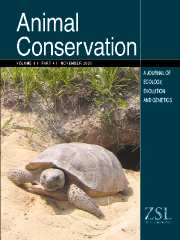Crossref Citations
This article has been cited by the following publications. This list is generated based on data provided by
Crossref.
Purvis, Andy
Jones, Kate E.
and
Mace, Georgina M.
2000.
Extinction.
BioEssays,
Vol. 22,
Issue. 12,
p.
1123.
Purvis, Andy
CarDillo, Marcel
Grenyer, Richard
and
Collen, Ben
2001.
Phylogeny and Conservation.
p.
295.
Fisher, Diana O.
and
Owens, Ian P.F.
2004.
The comparative method in conservation biology.
Trends in Ecology & Evolution,
Vol. 19,
Issue. 7,
p.
391.
Jones, Martin J.
Fielding, Alan
and
Sullivan, Matthew
2006.
Analysing Extinction Risk in Parrots using Decision Trees.
Biodiversity and Conservation,
Vol. 15,
Issue. 6,
p.
1993.
Konvicka, Martin
Fric, Zdenek
and
Benes, Jiri
2006.
Butterfly extinctions in European states: do socioeconomic conditions matter more than physical geography?.
Global Ecology and Biogeography,
Vol. 15,
Issue. 1,
p.
82.
Sullivan, Matthew S.
Jones, Martin J.
Lee, David C.
Marsden, Stuart J.
Fielding, Alan H.
and
Young, Emily V.
2006.
A Comparison of Predictive Methods in Extinction Risk Studies: Contrasts and Decision Trees.
Biodiversity and Conservation,
Vol. 15,
Issue. 6,
p.
1977.
Mayhew, Peter J.
2007.
Why are there so many insect species? Perspectives from fossils and phylogenies.
Biological Reviews,
Vol. 82,
Issue. 3,
p.
425.
Purvis, Andy
2008.
Phylogenetic Approaches to the Study of Extinction.
Annual Review of Ecology, Evolution, and Systematics,
Vol. 39,
Issue. 1,
p.
301.
Purvis, Andy
2008.
Phylogenetic Approaches to the Study of Extinction.
Annual Review of Ecology, Evolution, and Systematics,
Vol. 39,
Issue. 1,
p.
301.
Krushelnycky, Paul D.
and
Gillespie, Rosemary G.
2010.
Correlates of vulnerability among arthropod species threatened by invasive ants.
Biodiversity and Conservation,
Vol. 19,
Issue. 7,
p.
1971.
Bielby, J.
Cardillo, M.
Cooper, N.
and
Purvis, A.
2010.
Modelling extinction risk in multispecies data sets: phylogenetically independent contrasts versus decision trees.
Biodiversity and Conservation,
Vol. 19,
Issue. 1,
p.
113.
Forister, Matthew L.
Jahner, Joshua P.
Casner, Kayce L.
Wilson, Joseph S.
and
Shapiro, Arthur M.
2011.
The race is not to the swift: Long-term data reveal pervasive declines in California's low-elevation butterfly fauna.
Ecology,
Vol. 92,
Issue. 12,
p.
2222.
Hunter, Mark D.
Kozlov, Mikhail V.
Itämies, Juhani
Pulliainen, Erkki
Bäck, Jaana
Kyrö, Ella-Maria
and
Niemelä, Pekka
2014.
Current temporal trends in moth abundance are counter to predicted effects of climate change in an assemblage of subarctic forest moths.
Global Change Biology,
Vol. 20,
Issue. 6,
p.
1723.
Jeppsson, T.
and
Forslund, P.
2014.
Species' traits explain differences in Red list status and long-term population trends in longhorn beetles.
Animal Conservation,
Vol. 17,
Issue. 4,
p.
332.
Cardoso, Gonçalo C.
Cortesão, Marta
and
García, Cristina
2015.
Ecological Marginalization Facilitated Diversification in Conifers.
Evolutionary Biology,
Vol. 42,
Issue. 2,
p.
146.
Chichorro, Filipe
Juslén, Aino
and
Cardoso, Pedro
2019.
A review of the relation between species traits and extinction risk.
Biological Conservation,
Vol. 237,
Issue. ,
p.
220.

